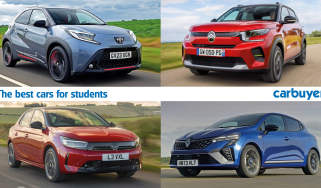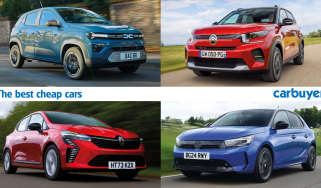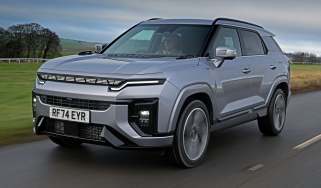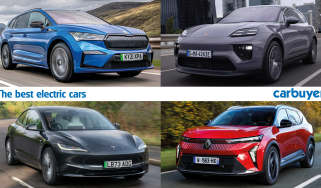Top 10 cars with the biggest boots
If carting cargo is your priority, our top 10 list of the biggest car boots is sure to be of interest, whatever your budget
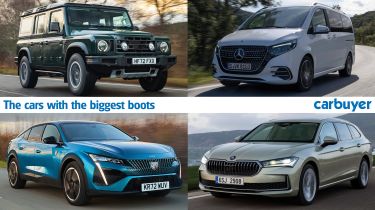
Priorities can vary from person to person when shopping for a new car, but most buyers will place boot space high on their list. Whether you regularly need to transport big items like sports equipment and DIY materials, or if you just need space for the annual holiday luggage, you’ll want a car with a big boot.
It won't surprise you that there are no sports cars on our list, but you'll see that you don't necessarily need to drive something that looks like a removal van in order to have a huge load area. That being said, van-based MPVs are still the luggage space champions, thanks to boxy dimensions and the option of extra-long variants. For most buyers though, they will be too big and bulky, which is why we have separated this list into different categories, including MPVs, SUVs, estate cars and hatchbacks.
 Top 10 best cars for cyclists and bikes
Top 10 best cars for cyclists and bikes
For SUVs, estate cars and hatchbacks, we’ve measured each car’s boot capacity with five seats in place. While it’s possible to fold down or entirely remove the rear seats in each of these cars, we expect most drivers to have a minimum of five seats in place most of the time, so this measurement provides the most useful real-world comparison.
The exception is MPVs. These are available with up to nine seats, but they often cannot be folded flat. Instead, we’ve used a measurement with all three rows of seating in place, with the rearmost seats slid forward to maximise space.
With that out of the way, here are the 10 biggest car boots you can get today…
MPVs
These are the MPVs on sale with the most boot space. Space has been measured with all three rows of seating in place, with the third row pushed forward.
1. Mercedes V-Class
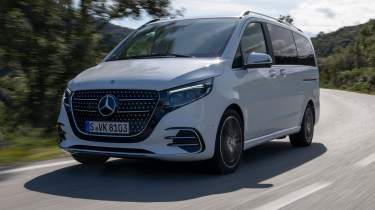
- 1,410 litres (seven seats in place)
The Mercedes V-Class is among the largest MPVs you can buy and, when ordered in the Extra Long bodystyle, it has the roomiest boot of them all. Closely related to the Mercedes Vito van – which is also available as a less-luxurious passenger vehicle – the V-Class can seat up to eight passengers. However, when the third row is pushed all the way forward, you're left with a truly colossal 1,410-litre load area. Even the slightly shorter Long variant can fit a whopping 1,030 litres behind the rear seats.
The boxy form of the V-Class means it isn't the most elegant of cars, but it makes up for this by offering a spacious interior which feels befitting of a true Mercedes-Benz. The V in V-Class really could stand for “VIP”, and it isn’t cheap, costing from just under £75,000. A Marco Polo camping version is also offered, complete with a pop-up roof that conceals beds for two, and a kitchenette with cool box and two-burner gas hob.
2. Ford Tourneo Custom
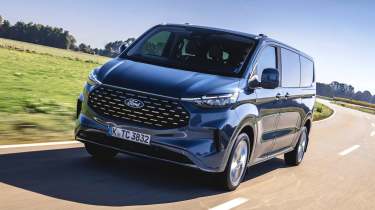
- 999 litres (seven seats in place)
Just as the Mercedes V-Class uses the Vito van as its base, the Ford Tourneo Custom is a passenger version of the Transit. As a result, you get a vast interior with nine seats and an equally big boot – 999-litres in the long wheelbase variant to be precise. Remove all the seats bar the front row and you’re left with 5,472-litres of space for all your cargo-hauling desires.
Thankfully, the Tourneo Custom feels closer to a car than a van from behind the wheel, with impressive ride comfort and low levels of road and wind noise. It’s perfectly at home on the motorway, although some drivers may find its large size a bit unwieldy around town. The interior is surprisingly pleasant, with an easy-to-use 13-inch infotainment touchscreen and plenty of storage cubbies dotted throughout the cabin. The strong range of diesel engines will suit most buyers, but there’s a petrol plug-in hybrid too, and even an EV variant with over 200 miles of range.
3. Peugeot E-Traveller
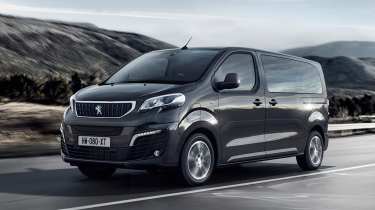
- 989 litres (seven seats in place)
Rounding out our list of roomy MPVs is another people carrier with van-based roots, this time from France. The Peugeot E-Traveller is an all-electric nine-seater, with 989 litres of boot space behind the third row of seats in Long specification – the regular version makes do with 603 litres. Removing the rear seats increases the capacity up to an enormous 3,497 litres – a figure that’s only measured up to the window line. Be warned though, those seats are fairly heavy and tricky to remove.
The E-Traveller went electric-only in 2022, replacing the typical diesel rumble with a near-silent powertrain. The interior is so big that we found it to be a bit echoey during our in-depth test, but it’s comfortable and well-equipped – although still some way behind the Ford and Mercedes above. Its 50kWh battery is large enough to manage over 140 miles of range, which may put off some buyers. If you stick to relatively short journeys, and don’t mind parking a five-metre-long vehicle, then the E-Rifter could be your ideal cargo hauler.
Citroen and Vauxhall both sell an equivalent version of the E-Traveller with identical boot space figures, called the e-SpaceTourer and Vivaro Life Electric, respectively.
SUVs
These SUVs have the largest boots in their class. All figures are taken with five seats in place.
1. Ineos Grenadier
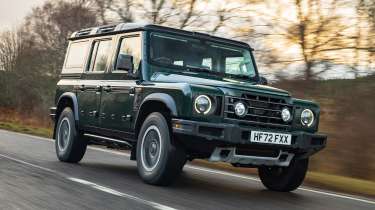
- 1,152 litres (five seats in place)
The Ineos Grenadier was designed to be tough, practical and capable off-road from the outset, with the original Land Rover Defender serving as its inspiration. The result is a shamelessly boxy SUV that packs an astounding 1,152 litres of boot space in five-seat configuration, growing to a van-rivalling 2,035 litres with all but the front seats removed.
While the cabin has some pleasant touches, including a 12.3-inch infotainment screen and a smattering of tactile buttons and switches, the Grenadier is first and foremost an off-roader. It doesn’t feel as well-built or as refined on the road as similarly-priced SUVs, with vague steering and noticeable wind noise. However, its utilitarian nature will appeal to certain buyers looking for the ultimate in go-anywhere toughness – and boot space.
2. Land Rover Defender
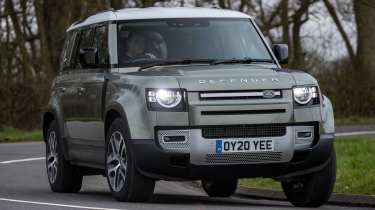
- 1,050 litres (five seats in place)
The latest Land Rover Defender tackles the all-terrain SUV brief in a slightly different manner to the Ineos, but it still packs an enormous boot – up to 1,050 litres in Defender 130 spec with five seats. At 5,358mm long, the Defender 130 is a behemoth – it’s even longer than a Range Rover LWB. Most families can probably make do with the slightly smaller Defender 110, which still has an impressive 786 litres of boot space.
Like Defenders of old, the latest model can tackle everything from muddy tracks to desert dunes without breaking a sweat. However, those off-road talents haven’t come at the expense of on-road refinement. It’s morphed from a farmyard workhorse into a genuine luxury car, with a simple yet beautifully executed interior and a composed, comfortable ride. Sure, it’s expensive, but there are few cars as capable as the Defender.
3. Land Rover Discovery
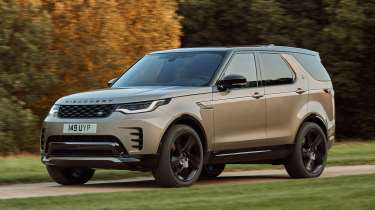
- 922 litres (five seats in place)
Since the introduction of the aforementioned Defender, you could argue that the Land Rover Discovery has been made redundant, but it still remains an excellent family SUV in its own right, with seven seats, punchy engines and an impressive 922-litre boot. Having been on sale since 2016, it’s fair to say that some rivals have moved on in terms of design and interior tech, but you can’t argue with the Disco’s quiet cabin and comfortable air suspension that help to make it a bit more luxurious than the Defender.
Practicality is where the Discovery leaps ahead of an Audi Q7 or BMW X5. The rearmost row of seats can fit six-foot passengers in comfort, while the second-row seats get split-folding functionality. This allows you to configure the seats just how you need, trading seating space for added cargo capacity. Drop all the seats, and boot space swells to 1,997 litres.
Estate cars
You won’t find an estate car with more boot space than these. All figures are taken with five seats in place.
1. Skoda Superb Estate
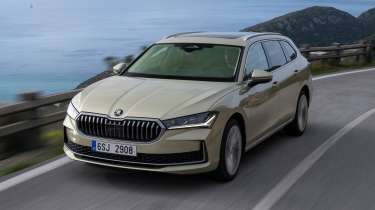
- 690 litres (five seats in place)
The latest Skoda Superb Estate ticks practically every family car box. It’s comfy, safe and has a 690-litre boot that’s big enough to haul all the shopping, kids’ gear, and the family labrador. The previous-generation car was a Carbuyer favourite, and the latest Superb builds upon the strengths of its predecessor with more efficient engines and an interior that lives up to the name.
Up front, the cabin is intuitively laid out, with a large 13-inch infotainment touchscreen above a row of ‘smart dials’. These can be configured to control different interior functions, from the temperature to the driving modes, meaning the driver doesn’t have to fiddle around with the touchscreen on the move. Elsewhere you’ll find other clever storage solutions, such as the large box in the centre armrest and the folding flaps in the boot floor to secure loose boxes.
2. Volkswagen Passat
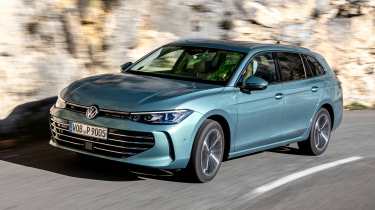
- 690 litres (five seats in place)
Sharing its platform with the Skoda Superb, it’s not surprising that the latest Volkswagen Passat has an identical 690-litre boot. Volkswagen dropped the saloon variant for the latest generation Passat, but we think the estate has always been the better family car, with its added practicality making holidays or trips to the tip that little bit easier.
Volkswagen has positioned the new Passat further upmarket than before in a bid to steal sales from the BMW 3 Series Touring and Audi A4 Avant. While it beats those rivals for boot space, we found its interior felt less special and, more importantly, trickier to use. A reliance on touchscreen menus can be frustrating, but at least the Passat comes with a long list of standard equipment and a range of efficient engines.
3. Skoda Octavia Estate
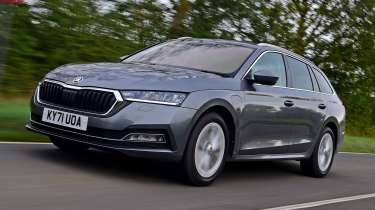
- 640 litres (five seats in place)
It seems that Skoda has the practicality formula nailed, as it takes a second spot on the list of biggest estate car boots, this time with the Octavia Estate at 640 litres. Despite losing around 200mm in length compared to the Superb, the Octavia is nearly just as practical, and features an interior that punches above its price. We think it's so good, in fact, that we question if any families need the bigger Superb.
A facelift for 2024 has brought a host of tech upgrades and some sharper styling, but the focus on affordability and utility remains. There’s a solid range of Volkswagen Group engines on offer, from frugal diesels, to mild-hybrid petrols and even a potent 242bhp unit in the sporty vRS model. We reckon there’s an Octavia model to suit every family, so it's no surprise that it won our Best Estate Car award this year.
Hatchbacks
Not all hatchbacks have tiny boots – these are the three with the biggest in their class. All figures are taken with five seats in place.
1. Skoda Octavia
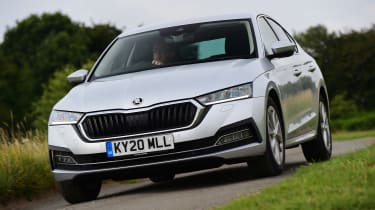
- 600 litres (five seats in place)
Spot of déjà vu? Yes, the Skoda Octavia appears for a second time on this list, as the hatchback with the largest boot on sale. While it may look like a saloon in profile, a hatchback rear lid helps to boost cargo space to 600 litres – that’s 220 litres more than a Volkswagen Golf. This can be increased to a vast 1,555 litres by folding the rear seats.
The estate may have it pipped for outright practicality, but the hatchback is still a roomy family car option.
2. Hyundai Ioniq 5
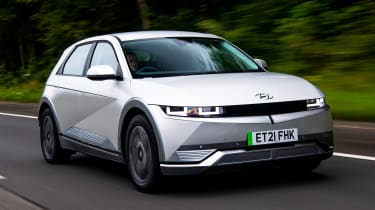
- 588 litres (five seats in place)
There are few hatchbacks on the road that stand out quite like the Hyundai Ioniq 5. Its retro styling touches and boxy proportions certainly look the part, but they also package a respectable 588 litre boot. This is in part due to the Ioniq 5’s size – it may look like a nimble supermini in photos, but don’t be fooled – it's actually longer and wider than a Tucson SUV. While that does have its drawbacks when parking or navigating tight city streets, it pays dividends on the inside.
The cabin is airy and roomy, helped by a completely flat floor that you often find in electric cars. Fold the rear seats flat, and the boot expands to 1,587 litres – enough for all but the largest of DIY supplies. The driver gets a pleasant cockpit with a pair of sharp screens, along with plenty of safety tech. Either a 58kW or 77.4 kWh battery provides power, with range standing at 238 and 315 miles respectively. There’s even the rapid Ioniq 5 N, for those who’ll be hauling cargo in a hurry.
3. Peugeot 408
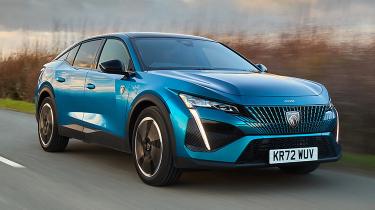
- 536 litres (five seats in place)
The Peugeot 408 is a completely new name for the car brand, and while it somewhat blurs the lines between hatchback, saloon and SUV bodystyles, Peugeot itself brands it a ‘C-segment fastback’ – that means it’s a car to be considered alongside hatchbacks like the Volkswagen Golf and Ford Focus. Despite its swoopy styling, the petrol versions boast a massive 536 litres of boot space with all the seats up (shrinking to 471 litres in the plug-in hybrid). Fold the seats down and the space increases to a cavernous 1,611 litres – perfect if you need to transport much larger items.
The 408’s slightly larger size compared to the 308 has also translated to more passenger space. Whereas in the 308 rear-seat passengers are left wanting for kneeroom, the 408 allows for even taller adults to stretch out their legs a little more, although the sloping roofline affects headroom somewhat. Other reasons to consider a Peugeot 408 include its striking and futuristic cabin, which feels very polished and high quality – the brand’s quirky i-Cockpit design means you get a small steering wheel and the digital dials are positioned higher up above it, so check you like the driving position before you buy.
How to buy a car with a big boot
While checking the on-paper boot capacity figures is a good start, there’s much more to researching if a car’s boot space and practicality are adequate in a prospective new car.
We recommend heading out to view some of the cars with the biggest boots to get a feel for what they’re like in person and follow some of the below tips:
- Some manufacturers measure boot space in a different way from others – for instance, check whether the boot volume figure is calculated to the parcel shelf or roof as this can make a big difference.
- Don’t be afraid to take a tape measure if there are regular items you may need to transport to ensure they fit in the back.
- Don’t just look at the boot – play around with the rearmost seats to see if they slide or adjust on runners and whether they split to allow for even more versatility.
- In addition to the last point, check that boot space doesn’t come at a heavy compromise to rear-passenger space if you also need to transport people regularly.
- Check how high the boot load lip is – if it’s too high it may be hard to get heavy items into it. Similarly, open and close the tailgate a few times to check it isn’t too high up or heavy for you to operate comfortably.
- Is it well designed? Look for extra underfloor storage or an adjustable boot floor, hooks, nets, cubby holes and storage solutions elsewhere in the car.
- Is the tailgate easy to open? If you park in tight spaces regularly, you may need to check there’s enough clearance to open the boot itself – a MINI Clubman’s barn-door style tailgate needs a lot of clearance, for example.
- Don’t be afraid to bring items you might regularly need to store along to the dealership to test the boot, such as a pushchair or bicycle.
Why not check out our guides to the Best cars for dog owners and Best 4x4s and SUVs.
Recommended

New Skoda Superb SportLine joins the range with sportier looks and £42k starting price
Most Popular
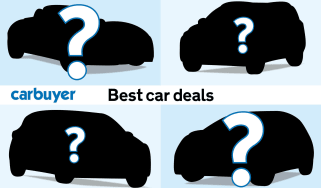
Best new car deals 2025: this week’s top car offers
Tips & advice

Car dashboard warning lights: what does each symbol mean?

Electric car charging stations: public networks, charger types, apps and maps

